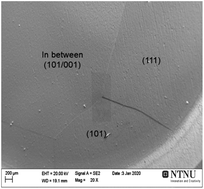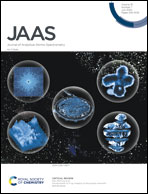Influence of polycrystalline material on crater shape optimization and roughness using low-power/low-pressure direct-current glow discharge mass spectrometry†
Abstract
Depth profiling is an attractive approach for analysis of non-homogeneous samples and layered materials. This application requires an optimum sputtered crater profile, which means a flat crater bottom with steep walls and a low roughness. It is known that discharge parameters are one of the most important factors influencing the crater shape. Hence, in the present work, different combinations of GDMS discharge current, voltage and argon flow, giving a flat crater bottom in tantalum are presented. A combination of mechanical profilometry, scanning electron microscopy and electron back scattered diffraction is used to show the contribution of grain orientation on various sputtering characteristics and crater bottom roughness. The results of the study indicate that differential sputtering is consistent at both higher and lower discharge conditions. The crater bottom roughness can be attributed to the differential sputtering of grains in polycrystalline materials.



 Please wait while we load your content...
Please wait while we load your content...